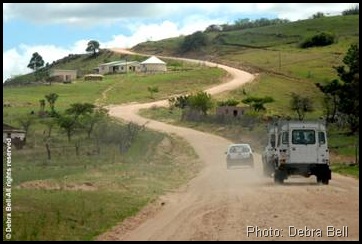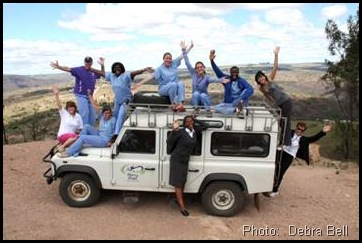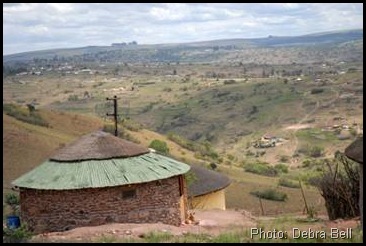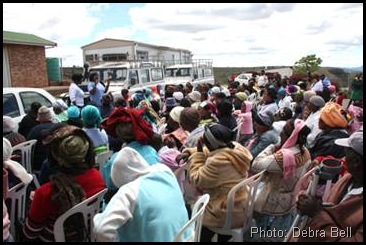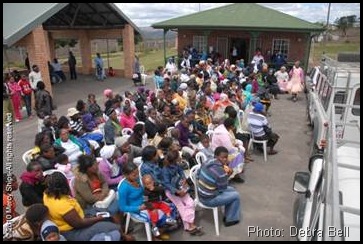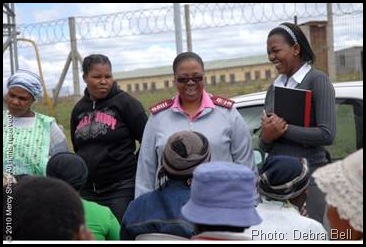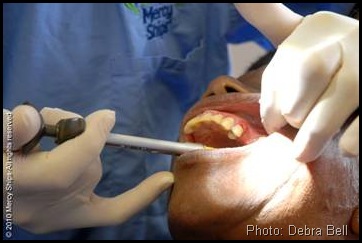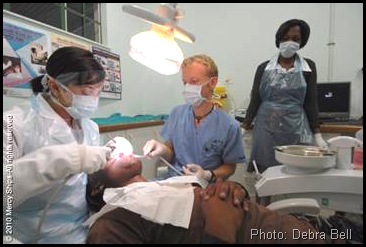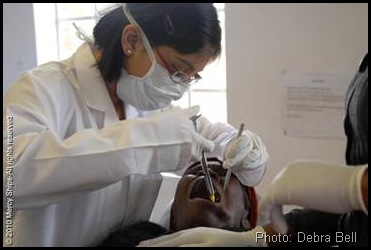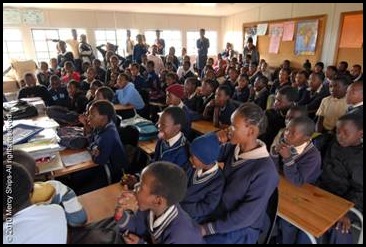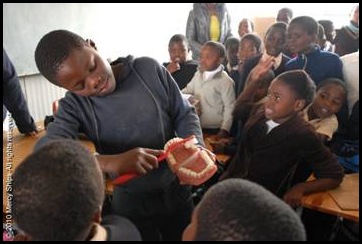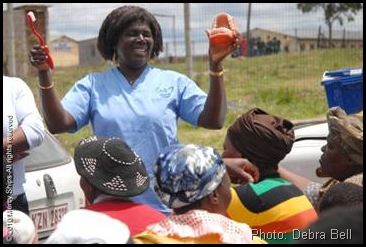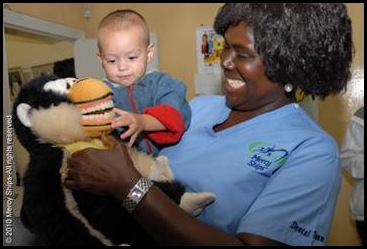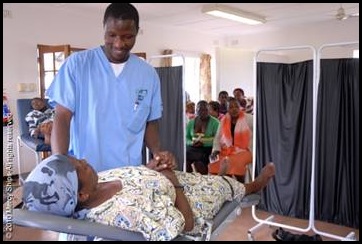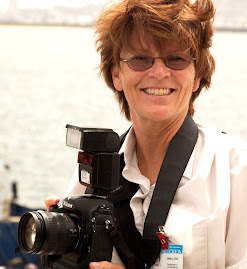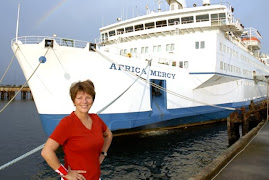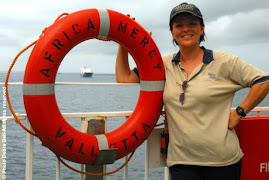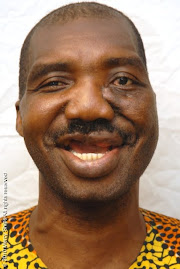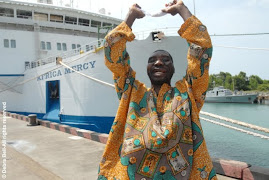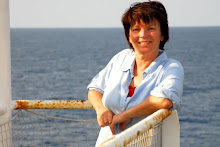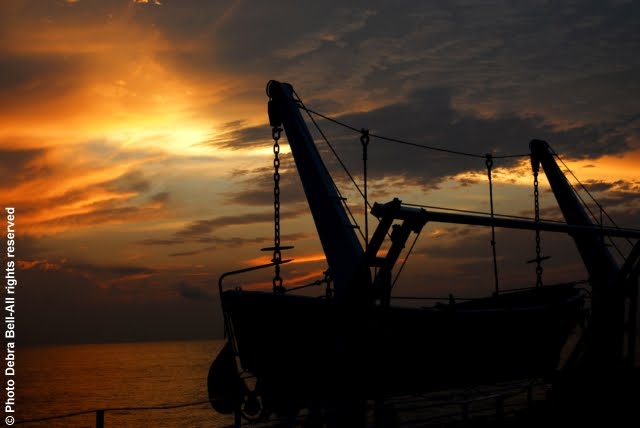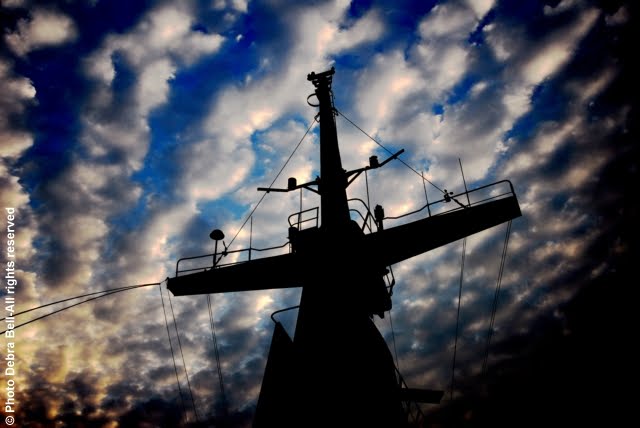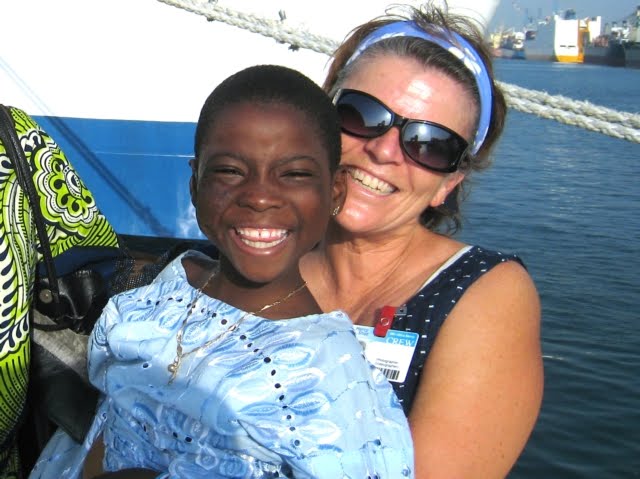Almost 23,000 people in South Africa’s Eastern Cape Province are unnecessarily blind; blind because they are not aware that cataract surgery can restore their sight. The 2010 Sabona Sonke Campaign, a three-phase plan of intervention, is in process at three area hospitals to offer a workable system at each site, to increase effective eye care to those with little or no access to medical care.
![clip_image002[4] clip_image002[4]](http://lh5.ggpht.com/_Tt31Us-agcc/TPPEEdmEqEI/AAAAAAAABDA/wiNRSPi03mw/clip_image002%5B4%5D_thumb%5B13%5D.jpg?imgmax=800)
The Mercy Ships team, headed by Dr. Glenn Strauss, surgeon and lead consultant, is teaming with The Fred Hollows Foundation South Africa, the Eastern Cape Provincial Department of Health and management professionals from each hospital to use the current resources most efficiently. The hospitals involved include the Port Elizabeth Hospital Complex, Nelson Mandela Academic Hospital, and Sabona Eye Centre in Queenstown. The program will be in effect for about three weeks at each hospital.
At a meeting of those involved at the Nelson Mandela Academic Hospital in Mthatha, Dr. Strauss explained the importance of keeping the flow of patients constant. This requires that every part of the process must be working well within the system as well as outside. Outside obstacles include, among others, negative attitudes about eye treatment, and government stipends to the blind, which are often the only source of income.
In addition to Dr. Strauss, the Mercy Ships team includes Kim Strauss, patient coordinator; Dr. Richard Newsom, eye surgeon and consultant; Glenys Gillingham, surgical nurse and head of the surgical team; Woody Hopper, consulting optometrist and head of screening; Robin Hopper, educational team leader, administrator and management coordinator; and Shannon Hickey, team member.
Phase one of the program begins with assessment of the current
system, training of eye teams and an orientation in Mercy Ships Vision Training, and transporting of patients to hospital locations. The second phase calls for the training of ophthalmologists in the Mercy Ships expedited procedure of cataract removal, and the referrals of cataract patients to be received at the hospital sites. The final phase includes the cataract operations, assessment and debriefing of the cataract surgeries, and the continuation of the program at future sites.
Screening sites for the Port Elizabeth program were held at Settlers, Uitenhage and Motherwell. The Queenstown screening sites for the Sabona Eye Centre were held at SS Gida Hospital, Aliwal North, Empilisweni and Cofimvaba. Butterworth, St. Elizabeth, St. Patrick and Madzikane kaZulu were the screening sites for the Program at Nelson Mandela Academic Hospital in Mthatha.
![clip_image002[26] clip_image002[26]](http://lh6.ggpht.com/_Tt31Us-agcc/TPPEUGuONQI/AAAAAAAABEA/PQWaoxCSnb0/clip_image002%5B26%5D_thumb%5B6%5D.jpg?imgmax=800)
Many cataract patients of Optometrist Tseli Khalatha, and others who gained knowledge of the program by word of mouth, crowded the screening site in Butterworth, hoping to have their sight restored. Mr. Khalatha was in charge of admissions at the screening, doing the initial check for cataracts and moving them onto the next step in the process of tagging appropriate patients for the surgery.
Robin Hopper and Shannon Hickey did biometry testing, checking measurements inside the eye, and Woody Hopper used the slit lamp, a diagnostic tool for cataracts, the final step in the screening process.
Dr. Strauss is working closely with ophthalmologists at each location, and hopes this process will open doors to new strategies for addressing blindness that will
be duplicated easily in other areas.
Phase II - Eye Surgery
The Nelson Mandela Academic Hospital in Mthatha, South Africa, is a fine facility that stands ready to handle the medical needs of the community. However, there are obstacles that prevent the people from utilizing the hospital to full potential. First, there are many who need the medical services but can’t afford them; and second, the prevailing attitude is that the hospital is where one goes to die. This belief brings many to an early death who might otherwise be on the road to healing and good health once again.
![clip_image002[58] clip_image002[58]](http://lh5.ggpht.com/_Tt31Us-agcc/TPPEn7Z-VCI/AAAAAAAABFQ/oH9YUzfaJsk/clip_image002%5B58%5D_thumb%5B3%5D.jpg?imgmax=800)
Medical professionals in the Eastern Cape region are working to eliminate these obstacles. The 2010 Sabona Sonke Campaign is one of their most successful efforts. This plan of intervention focuses on increasing effective eye care to those with no other medical access. The Mercy Ships team, under the leadership of Dr. Glenn Strauss, eye surgeon and lead consultant, is teaming with The Fred Hollows Foundation South Africa, the Eastern Cape Provincial Department of Health and management professionals from three area hospitals to use available resources to provide cataract surgeries to eliminate blindness among the poorest citizens, without charge.
At the Mandela Hospital, candidates arrived by shuttle from the Butterworth screening site, and were prepared for cataract surgery. Dr. Strauss and Dr. Richard Newsom, eye surgeon and consultant, who have teamed to train surgeons in the Mercy Ships expedited procedure of cataract removal, joined Head Surgeon Dr. Carolina Salazar, Dr. Laveen Naidoo, and Dr. Thabo Matubatuba of the Mandela Hospital.
The surgeries began, as Surgical Nurse Glenys Gillingham, head of the surgical team, started instruction with the hospital’s ophthalmic nurses in their new procedures to better assist the doctors. The expedited cataract surgery training proceeded throughout the day under the expert supervision of Dr. Strauss and Dr. Newsom.
![clip_image002[68] clip_image002[68]](http://lh6.ggpht.com/_Tt31Us-agcc/TPPEsu_857I/AAAAAAAABFo/KdvVX9cCxRQ/clip_image002%5B68%5D_thumb%5B3%5D.jpg?imgmax=800)
Dr. Salazar, who came from Cuba to work for a year in the South African hospital, is now completing her thirteenth year at the facility. “I love the work that he (Dr. Strauss) is doing,” she said. “It’s nice to have colleagues around. We all have the same purpose; to help patients,”
Mandoyisile Esther Ntanjana, one of the cataract patients, was totally blind. Her neighbor was also blind, but had recovered her sight after a similar surgery. The neighbor encouraged Mandoyisile to have the procedure. Zimasa, Mandoyisile’s daughter-in-law, came to visit her as she recovered in the ward. The brilliant smile that greeted her relayed her great joy after the successful surgery. Zimasa translated her mother-in-law’s excited words after the successful surgery. “I had a dark view before. Now I can see! I am happy!”
![clip_image002[84] clip_image002[84]](http://lh5.ggpht.com/_Tt31Us-agcc/TPPEC5zmRgI/AAAAAAAABC4/3BRA-4CPhA8/clip_image002%5B84%5D_thumb%5B5%5D.jpg?imgmax=800)
![clip_image002[8] clip_image002[8]](http://lh4.ggpht.com/_Tt31Us-agcc/TPPEHNaENkI/AAAAAAAABDI/fHntwIluCGc/clip_image002%5B8%5D_thumb%5B8%5D.jpg?imgmax=800)
![clip_image002[10] clip_image002[10]](http://lh5.ggpht.com/_Tt31Us-agcc/TPPEIoHv9gI/AAAAAAAABDQ/zfjEApHkI-4/clip_image002%5B10%5D_thumb%5B7%5D.jpg?imgmax=800)
![clip_image002[12] clip_image002[12]](http://lh5.ggpht.com/_Tt31Us-agcc/TPPEKjCbflI/AAAAAAAABDY/xSSqOE54tTk/clip_image002%5B12%5D_thumb%5B3%5D.jpg?imgmax=800)
![clip_image002[16] clip_image002[16]](http://lh4.ggpht.com/_Tt31Us-agcc/TPPEMieSWKI/AAAAAAAABDg/wW6B8YywFg4/clip_image002%5B16%5D_thumb%5B3%5D.jpg?imgmax=800)
![clip_image002[18] clip_image002[18]](http://lh4.ggpht.com/_Tt31Us-agcc/TPPEPWVDBwI/AAAAAAAABDw/JhxeiDwlDrI/clip_image002%5B18%5D_thumb%5B4%5D.jpg?imgmax=800)
![clip_image002[24] clip_image002[24]](http://lh3.ggpht.com/_Tt31Us-agcc/TPPERR0eGNI/AAAAAAAABD4/Vy6yFwjKVng/clip_image002%5B24%5D_thumb%5B3%5D.jpg?imgmax=800)
![clip_image002[32] clip_image002[32]](http://lh5.ggpht.com/_Tt31Us-agcc/TPPEWSPMIrI/AAAAAAAABEI/Xh3F8TRrHgc/clip_image002%5B32%5D_thumb%5B3%5D.jpg?imgmax=800)
![clip_image002[34] clip_image002[34]](http://lh3.ggpht.com/_Tt31Us-agcc/TPPEYlkhi7I/AAAAAAAABEQ/Ryb9gkERiPg/clip_image002%5B34%5D_thumb%5B4%5D.jpg?imgmax=800)
![clip_image002[36] clip_image002[36]](http://lh5.ggpht.com/_Tt31Us-agcc/TPPEbXzkDUI/AAAAAAAABEY/CDqnXyXOnxs/clip_image002%5B36%5D_thumb%5B3%5D.jpg?imgmax=800)
![clip_image002[40] clip_image002[40]](http://lh6.ggpht.com/_Tt31Us-agcc/TPPEdMJufwI/AAAAAAAABEg/HJ0JuehbyUs/clip_image002%5B40%5D_thumb%5B3%5D.jpg?imgmax=800)
![clip_image002[42] clip_image002[42]](http://lh3.ggpht.com/_Tt31Us-agcc/TPPEfUySfnI/AAAAAAAABEo/HMI9xhc-Jkg/clip_image002%5B42%5D_thumb%5B3%5D.jpg?imgmax=800)
![clip_image002[44] clip_image002[44]](http://lh6.ggpht.com/_Tt31Us-agcc/TPPEhVpNT5I/AAAAAAAABEw/rJzjMkTH99I/clip_image002%5B44%5D_thumb%5B10%5D.jpg?imgmax=800)
![clip_image002[48] clip_image002[48]](http://lh6.ggpht.com/_Tt31Us-agcc/TPPEjLkaq5I/AAAAAAAABE4/deqwWfDl280/clip_image002%5B48%5D_thumb%5B3%5D.jpg?imgmax=800)
![clip_image002[54] clip_image002[54]](http://lh6.ggpht.com/_Tt31Us-agcc/TPPEktKAXOI/AAAAAAAABFA/yh8slHFpn84/clip_image002%5B54%5D_thumb%5B3%5D.jpg?imgmax=800)
![clip_image002[56] clip_image002[56]](http://lh5.ggpht.com/_Tt31Us-agcc/TPPEmQuUG-I/AAAAAAAABFI/wgJ1cjwqOgM/clip_image002%5B56%5D_thumb%5B3%5D.jpg?imgmax=800)
![clip_image002[64] clip_image002[64]](http://lh6.ggpht.com/_Tt31Us-agcc/TPPEpUeh2OI/AAAAAAAABFY/Jlckvd9bstk/clip_image002%5B64%5D_thumb%5B3%5D.jpg?imgmax=800)
![clip_image002[66] clip_image002[66]](http://lh4.ggpht.com/_Tt31Us-agcc/TPPEq8Cl17I/AAAAAAAABFg/zasAQ0Ru4tQ/clip_image002%5B66%5D_thumb%5B3%5D.jpg?imgmax=800)
![clip_image002[70] clip_image002[70]](http://lh4.ggpht.com/_Tt31Us-agcc/TPPEumDmljI/AAAAAAAABFw/3-bOJXVZhP4/clip_image002%5B70%5D_thumb%5B3%5D.jpg?imgmax=800)
![clip_image002[72] clip_image002[72]](http://lh4.ggpht.com/_Tt31Us-agcc/TPPEwGtQkMI/AAAAAAAABF4/ZSz11OrUKqU/clip_image002%5B72%5D_thumb%5B3%5D.jpg?imgmax=800)
![clip_image002[76] clip_image002[76]](http://lh6.ggpht.com/_Tt31Us-agcc/TPPEx3lPIYI/AAAAAAAABGA/qNyKwlpT0wQ/clip_image002%5B76%5D_thumb%5B3%5D.jpg?imgmax=800)
![clip_image002[78] clip_image002[78]](http://lh3.ggpht.com/_Tt31Us-agcc/TPPEzlWJ3nI/AAAAAAAABGI/x5XUJfstx_M/clip_image002%5B78%5D_thumb%5B4%5D.jpg?imgmax=800)
![clip_image002[82] clip_image002[82]](http://lh6.ggpht.com/_Tt31Us-agcc/TPPE0yy7GtI/AAAAAAAABGQ/TTmkQrsppTM/clip_image002%5B82%5D_thumb%5B7%5D.jpg?imgmax=800)
